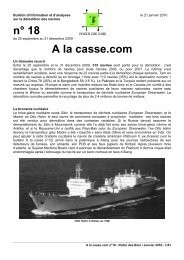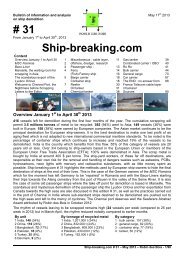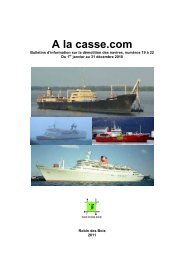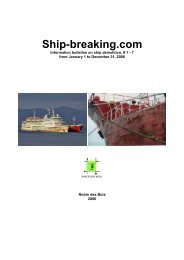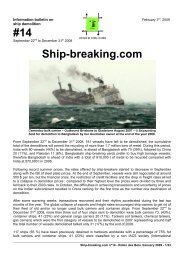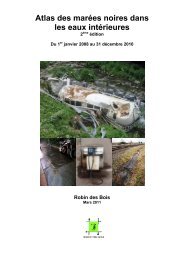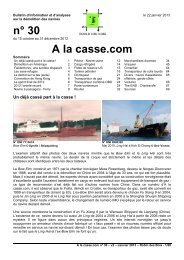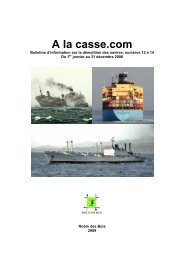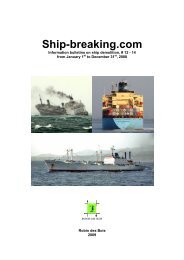Ship-breaking.com - Robin des Bois
Ship-breaking.com - Robin des Bois
Ship-breaking.com - Robin des Bois
Create successful ePaper yourself
Turn your PDF publications into a flip-book with our unique Google optimized e-Paper software.
4 th Quarter 2010 Statement<br />
India rules, Turkey has ambition and Europe is perhaps waking up …<br />
Between October 16 th and December 31 st 2010, 202 vessels have left to be demolished, at a rhythm of<br />
18 vessels a week. India with 78 vessels (39%) achieved the Grand Slam this year with their 4 th<br />
appearance as the number one spot of demolition in the tonnage category as well as total number of<br />
units to be recycled. With 38 vessels (19%) Turkey stays in second place and reasserts its ambitions<br />
with the purchase of three big Canadian bulk carriers in their forties, the Algoisle, the Agawa Canyon and<br />
the Canadian Prospector which used to sail on the Great Lakes, in addition to the small general cargo<br />
carriers and ferries. China <strong>com</strong>es in 3 rd place with 33 vessels (16%), ahead of Pakistan, 25 (12%) and<br />
Bangla<strong>des</strong>h 14 (7%). 5 vessels were demolished in Europe in Danish and Belgian ship-<strong>breaking</strong> yards.<br />
In Ghent, Van Heygen Recycling just receptioned two large Icelandic fishing vessels, and will demolish<br />
another twenty odd Scottish vessels originating from a de<strong>com</strong>missioning plan. Will Europe convert the<br />
try in 2011 and score more points in the fishing and merchant fleets?<br />
In terms of tonnage of scrap to be recycled, India is ahead of China, Pakistan, Bangla<strong>des</strong>h and Turkey.<br />
The accumulated total to be demolished is close to 1.3 million tons of metal. The oil, chemical and gas<br />
tankers represent this time the largest amount of vessels sent to be scrapped with a total of 64 vessels<br />
ie. 34%. In volume, the tankers represent more than 510,000 tons ie. 40% of recycled metal. General<br />
cargo carriers, 51 (25%), are next, ahead of bulk carriers, 31 (15%). The container ships, 7 (3%), and the<br />
car carriers, 4 (2%) have be<strong>com</strong>e rarities in ship-<strong>breaking</strong> yards.<br />
The prices offered by ship-<strong>breaking</strong> yards have remained stable, at around 475$ per ton for the tankers,<br />
450$ for the dry cargo carriers. The differential has narrowed, the prices offered by Chinese ship<strong>breaking</strong><br />
yards are only slightly less than those of the Indian or Pakistanese breakers. The prices have<br />
gone up in Turkey where vessels have found buyers for more than 300$ per ton.<br />
Of the 202 vessels, 75 (35%) were flying a European flag or belonged to European ship owners or<br />
members of the European Free Trade Association (EFTA). 95 (47%) were built in the same countries of<br />
which 3 in France namely in Brest, Dieppe and La Ciotat.<br />
After the bar, the scrapping<br />
79 (39%) of the vessels leaving to be broken up were controlled by a classification society which was not<br />
a member of IACS (International Association of Classification Societies) or had no classification society.<br />
The vessels not up to standards are always the first to leave: at least 89 (44%) were detained in the<br />
world’s ports with a total of detention of 71% for the reefers and more than 60% for the bulk carriers and<br />
general cargo carriers. The total of detentions was 16% for the oil tankers but 59% for the chemical<br />
tankers.<br />
Years and meters<br />
The end of service age of the vessels leaving the waters during the period of October 16 th to December<br />
31 st 2010 ranges between 15 for the gas carrier Golden Crux n°18 and the container ship Valley, two<br />
vessels which were respectively victims of an explosion or a collision, and 71 year old for the Guard<br />
Valiant, ex Norwegian whaler Thorgaut (see the saga under the chapter The END, page 37-38) ; the<br />
average age is 31 years; and it is 25 for double-hull tankers, 29 for single-hull tankers, 33 for bulk<br />
carriers and general cargo carriers, 37 for ferries and passenger ships and lastly 45 for fishing vessels<br />
whether converted or not and factory ships. 104 vessels were less than 150 m, 62 measured between<br />
150 and 199 m and 36 were more than 200 m in length. The largest vessel to be scrapped this quarter<br />
was the old VLCC (Very Large Crude Carrier) Maxus Widuri, aged 36 years, 347 m in length, used as a<br />
Floating Production Storage and Offloading unit<br />
<strong>Ship</strong>-<strong>breaking</strong>.<strong>com</strong> # 22 - <strong>Robin</strong> <strong>des</strong> <strong>Bois</strong> / January 2011 - 5/39



